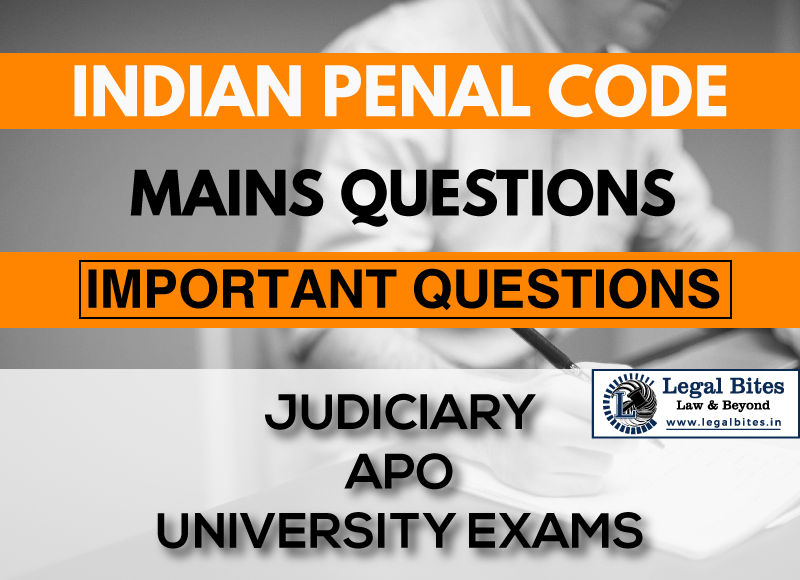Define, illustrate and discuss an unlawful assembly. State the difference between Section 34 and Section 149 of the I.P.C.
Question: Define, illustrate and discuss an unlawful assembly. State the difference between Section 34 and Section 149 of the I.P.C. [U.P.C.J. 1992, U.P.H.J.S. 2007, R.J.S. 1971, MPCJ 2007] Find the answer to the mains question only on Legal Bites. [Define, illustrate and discuss an unlawful assembly. State the difference between Section 34 and Section 149 of the I.P.C.]… Read More »

Question: Define, illustrate and discuss an unlawful assembly. State the difference between Section 34 and Section 149 of the I.P.C. [U.P.C.J. 1992, U.P.H.J.S. 2007, R.J.S. 1971, MPCJ 2007] Find the answer to the mains question only on Legal Bites. [Define, illustrate and discuss an unlawful assembly. State the difference between Section 34 and Section 149 of the I.P.C.] Answer Section 34 Acts done by several persons in furtherance of common intention.— When a criminal act is done by...
Question: Define, illustrate and discuss an unlawful assembly. State the difference between Section 34 and Section 149 of the I.P.C. [U.P.C.J. 1992, U.P.H.J.S. 2007, R.J.S. 1971, MPCJ 2007]
Find the answer to the mains question only on Legal Bites. [Define, illustrate and discuss an unlawful assembly. State the difference between Section 34 and Section 149 of the I.P.C.]
Answer
Section 34 Acts done by several persons in furtherance of common intention.— When a criminal act is done by several persons in furtherance of the common intention of all, each of such persons is liable for that act in the same manner as if it were done by him alone.
Section 149: Every member of unlawful assembly guilty of the offence committed in prosecution of the common object.— If an offence is committed by any member of an unlawful assembly in prosecution of the common object of that assembly, or such as the members of that assembly knew to be likely to be committed in prosecution of that object, every person who, at the time of the committing of that offence, is a member of the same assembly, is guilty of that offence.
Both the section when read carefully gives the distinction and differences between the common intention and common object respectively.
(1) Section 149 requires an assembly of five persons, whereas section 34 does not require such a fixed number.
(2) The ‘common object’ must be one specified in s 141, whereas under section 34, the ‘common intention’ may be any intention
(3) The offence actually committed is required by section 149 to be one which the members of the unlawful assembly knew to be likely to be committed in prosecution of the common object. It need not be a criminal act in actual furtherance of the common object which under section 34, it has to be.
(4) Section 34 requires some action, however small, to be done, is sufficient as its essence lies in the simultaneous consensus of the minds of persons participating in the criminal action to bring about a particular result, whereas, under section 149, mere membership of the assembly is sufficient.
(5) Section 34 enunciates a mere rule of evidence or a principle of liability, but creates no distinct offence, while section 149, though a declaratory provision, creates a specific offence.
The apex court, articulating the distinction between s 34 and s 149, in Chittarmal Moti v State of Rajasthan AIR 2003 SC 796 observed:
It is well settled by a catena of decisions that section 34 as well as section 149 deal with liability for constructive criminality i.e. the vicarious liability of a person for acts of others. Both the sections deal with a combination of persons who become punishable as sharers in an offence. Thus, they have a certain resemblance and may to some extent overlap. But a clear distinction is made out between common intention and common object in that common intention denotes action in concert and necessarily postulates the existence of a pre-arranged plan implying a prior meeting of the minds, while common object does not necessarily require proof of prior meeting of minds or pre-concert.
Though there is a substantial difference between the two sections, they also to some extent overlap and it is a question to be determined on the facts of each case whether the charge under section 149 overlaps the ground covered by section 34.
Thus, if several persons numbering five or more do an act and intend to do it, both sections 34 and section 149 may apply. If the common object does not necessarily involve a common intention, then the substitution of section 34 for section 149 might result in prejudice to the accused and ought not, therefore, to be permitted. But if it does involve a common intention then the substitution of section 34 for section 149 must be held to be a formal matter. Whether such recourse can be had or not must depend on the facts of each case.
The non-applicability of section 149 is, therefore, no bar in convicting the appellants under section 302 read with section 34, if the evidence discloses commission of an offence in furtherance of the common intention of them all
Important Mains Questions Series for Judiciary, APO & University Exams
- IPC Mains Questions Series Part I: Important Questions
- IPC Mains Questions Series Part II: Important Questions
- IPC Mains Questions Series Part III: Important Questions
- IPC Mains Questions Series Part IV: Important Questions
- IPC Mains Questions Series Part V: Important Questions
- IPC Mains Questions Series Part VI: Important Questions
- IPC Mains Questions Series Part VII: Important Questions
- IPC Mains Questions Series Part VIII: Important Questions
- IPC Mains Questions Series Part IX: Important Questions
- IPC Mains Questions Series Part X: Important Questions

Admin Legal Bites
Legal Bites Study Materials correspond to what is taught in law schools and what is tested in competitive exams. It pledges to offer a competitive advantage, prepare for tests, and save a lot of money.
